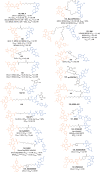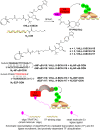PROTACs: great opportunities for academia and industry (an update from 2020 to 2021)
- PMID: 35680848
- PMCID: PMC9178337
- DOI: 10.1038/s41392-022-00999-9
PROTACs: great opportunities for academia and industry (an update from 2020 to 2021)
Abstract
PROteolysis TArgeting Chimeras (PROTACs) technology is a new protein-degradation strategy that has emerged in recent years. It uses bifunctional small molecules to induce the ubiquitination and degradation of target proteins through the ubiquitin-proteasome system. PROTACs can not only be used as potential clinical treatments for diseases such as cancer, immune disorders, viral infections, and neurodegenerative diseases, but also provide unique chemical knockdown tools for biological research in a catalytic, reversible, and rapid manner. In 2019, our group published a review article "PROTACs: great opportunities for academia and industry" in the journal, summarizing the representative compounds of PROTACs reported before the end of 2019. In the past 2 years, the entire field of protein degradation has experienced rapid development, including not only a large increase in the number of research papers on protein-degradation technology but also a rapid increase in the number of small-molecule degraders that have entered the clinical and will enter the clinical stage. In addition to PROTAC and molecular glue technology, other new degradation technologies are also developing rapidly. In this article, we mainly summarize and review the representative PROTACs of related targets published in 2020-2021 to present to researchers the exciting developments in the field of protein degradation. The problems that need to be solved in this field will also be briefly introduced.
© 2022. The Author(s).
Conflict of interest statement
The authors declare no competing interests.
Figures






















































































References
-
- Neklesa TK, et al. ARV-110: an androgen receptor PROTAC degrader for prostate cancer. Am. Assoc. Cancer Res. 2018;78:5236.
-
- Neklesa, T. K. et al. ARV-110: an oral androgen receptor PROTAC degrader for prostate cancer. J. Clin. Oncol.37, 14–16 (2019).
-
- Halford B. Arvinas unveils PROTAC structures. Chem. Eng. N. 2021;99:5.
Publication types
MeSH terms
Substances
LinkOut - more resources
Full Text Sources
Other Literature Sources
Miscellaneous

